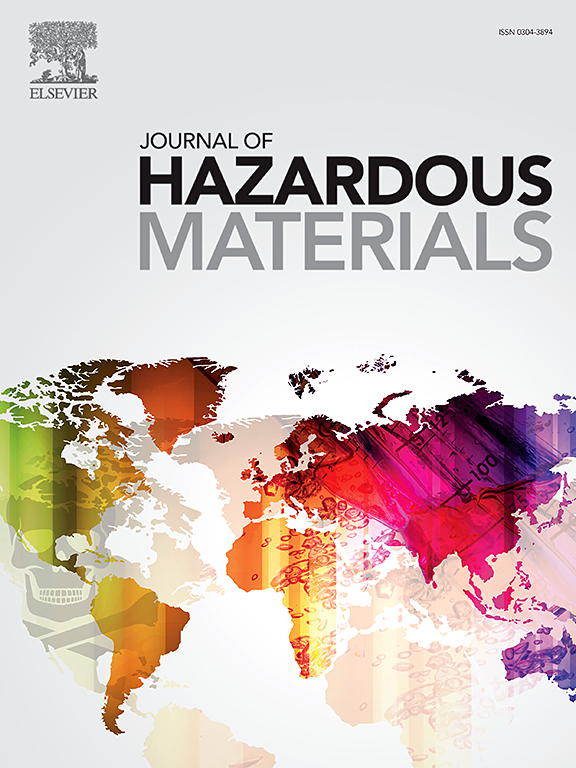A turn-on near-infrared fluorescent probe for monitoring carbon monoxide in bacterial pneumonia and cadmium ion induced abiotic stress responses in plants
IF 11.3
1区 环境科学与生态学
Q1 ENGINEERING, ENVIRONMENTAL
引用次数: 0
Abstract
Carbon monoxide (CO) is known as a highly toxic gas being emitted during industrial activities. Recent studies confirmed the roles of CO in various biological processes, such as bacterial pneumonia and plants response to abiotic stresses, that can be evaluated in situ using fluorescence probe technology. In this work, a Nile Red-based near-infrared fluorescence probe (Z1CO) is developed to evaluate CO production in animal and plant systems. The probe Z1CO is designed by conjugating allyl formate moiety that responds to CO specifically to Nile Red fluorophore. In the presence of CO with palladium chloride (PdCl2), Tsuji–Trost reaction facilitates the cleavage of the allyl formate moiety, resulting in bathochromic-shift of absorption spectra and enhancement of the emission at 665 nm within 60 min. Z1CO features several advantages, including near-infrared emission, large Stokes shift (75 nm), high selectivity, low detection limit (0.84 μM) and low cytotoxicity in vitro, enabling its applications in monitoring CO production in animal and plant systems. Visualization of CO production in lipopolysaccharide (LPS)-induced acute pneumonia mouse model, monitoring of CO-mediated inflammatory treatment responses and CO functions in plants response to cadmium ion (Cd2+)-induced abiotic stress are then demonstrated. This work thus provides a new tool for evaluating the roles of CO in animal and plant systems.

一种用于监测细菌性肺炎中一氧化碳和镉离子诱导植物非生物胁迫反应的开启近红外荧光探针
一氧化碳(CO)是工业活动中排放的一种剧毒气体。最近的研究证实了CO在各种生物过程中的作用,例如细菌性肺炎和植物对非生物胁迫的反应,这些作用可以使用荧光探针技术进行原位评估。在这项工作中,开发了一种基于尼罗河红的近红外荧光探针(Z1CO),用于评估动物和植物系统中CO的产生。探针Z1CO是通过偶联甲酸烯丙酯部分设计的,该部分对CO特异性地响应尼罗河红荧光团。在CO与氯化钯(PdCl2)存在的情况下,Tsuji-Trost反应促进了甲酸烯丙酯部分的裂解,导致吸收光谱发生色移,并在60分钟内增强了665 nm的发射。Z1CO具有近红外发射、大Stokes位移(75 nm)、高选择性、低检测限(0.84 μM)和低细胞毒性等优点,使其在体外应用于监测动物和植物系统中CO的产生。在脂多糖(LPS)诱导的急性肺炎小鼠模型中可视化CO的产生,监测CO介导的炎症治疗反应和CO在植物对镉离子(Cd2+)诱导的非生物应激反应中的功能。因此,这项工作为评估CO在动植物系统中的作用提供了一个新的工具。
本文章由计算机程序翻译,如有差异,请以英文原文为准。
求助全文
约1分钟内获得全文
求助全文
来源期刊

Journal of Hazardous Materials
工程技术-工程:环境
CiteScore
25.40
自引率
5.90%
发文量
3059
审稿时长
58 days
期刊介绍:
The Journal of Hazardous Materials serves as a global platform for promoting cutting-edge research in the field of Environmental Science and Engineering. Our publication features a wide range of articles, including full-length research papers, review articles, and perspectives, with the aim of enhancing our understanding of the dangers and risks associated with various materials concerning public health and the environment. It is important to note that the term "environmental contaminants" refers specifically to substances that pose hazardous effects through contamination, while excluding those that do not have such impacts on the environment or human health. Moreover, we emphasize the distinction between wastes and hazardous materials in order to provide further clarity on the scope of the journal. We have a keen interest in exploring specific compounds and microbial agents that have adverse effects on the environment.
 求助内容:
求助内容: 应助结果提醒方式:
应助结果提醒方式:


